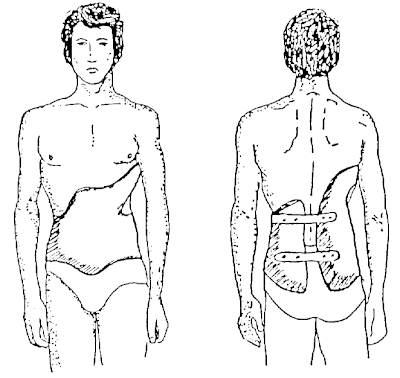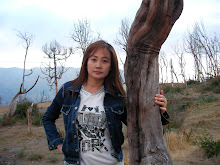A. What is Scoliosis?
Scoliosis is a medical condition in which a person's spine is curved from side to side, shaped like a "S", and may also be rotated. To adults it can be very painful. It is an abnormal lateral curvature of the spine. On an x-ray, the spine of an individual with a typical scoliosis may look more like an "S" or a "C" than a straight line. It is typically classified as congenital (caused by vertebral anomalies present at birth), idiopathic (sub-classified as infantile, juvenile, adolescent, or adult according to when onset occurred) or as having developed as a secondary symptom of another condition, such as cerebral palsy, spinal muscular atrophy or due to physical trauma.
Kyphosis is a curve seen from the side in which the spine is bent forward. Lordosis is a curve seen from the side in which the spine is bent backward. People with scoliosis develop additional curves to either side, and the bones of the spine twist on each other like a corkscrew.
The condition can be categorized based on convexity, or curvature of the spinal column, with relation to the central axis:
- Dextroscoliosis is a scoliosis with the convexity on the right side.
- Levoscoliosis is a scoliosis with the convexity on the left side.
- Rotoscoliosis (may be used in conjunction with dextroscoliosis and levoscoliosis, e.g. levorotoscoliosis) refers to scoliosis on which the rotation of the vertebrae is particularly pronounced, or is used simply to draw attention to the fact that scoliosis is a complex 3 dimensional problem.
B. Is Scoliosis Genetic?
There is a definite genetic connection, with around 25% of those with a scoliosis have a direct relative with a curvature. 80% of adolescence idiopathic scoliosis arises in girls, and 80% of these girls have their rib prominence on the right side.
Abnormalities at birth or improper development may be the biggest ways heredity plays a role in scoliosis.
Scoliosis is not caused by a child having poor posture or carrying too much weight in a backpack.
C. Types of Scoliosis
There are three other main types of scoliosis:
Functional: In this type of scoliosis, the spine is normal, but an abnormal curve develops because of a problem somewhere else in the body. This could be caused by one leg being shorter than the other or by muscle spasms in the back.
Neuromuscular: In this type of scoliosis, there is a problem when the bones of the spine are formed. Either the bones of the spine fail to form completely, or they fail to separate from each other. This type of scoliosis develops in people with other disorders including birth defects, muscular dystrophy, cerebral palsy, or Marfan's disease. If the curve is present at birth, it is called congenital. This type of scoliosis is often much more severe and needs more aggressive treatment than other forms of scoliosis.
Degenerative: Unlike the other forms of scoliosis that are found in children and teens, degenerative scoliosis occurs in older adults. It is caused by changes in the spine due to arthritis. Weakening of the normal ligaments and other soft tissues of the spine combined with abnormal bone spurs can lead to an abnormal curvature of the spine.
Others: There are other potential causes of scoliosis, including spine tumors such as osteoid osteoma. This is a benign tumor that can occur in the spine and cause pain. The pain causes people to lean to the opposite side to reduce he amount of pressure applied to the tumor. This can lead to a spinal deformity.
D. Scoliosis Causes
Doctors don't know what causes the most common type of scoliosis. When a cause can't be identified, scoliosis is called idiopathic.
Various causes have been implicated, but none has consensus among scientists as the cause of scoliosis. Scoliosis is more often diagnosed in females and is often seen in patients with cerebral palsy or spina bifida, although this form of scoliosis is different from that seen in children without these conditions. In some cases, scoliosis exists at birth due to a congenital vertebral anomaly. Occasionally, development of scoliosis during adolescence is due to an underlying anomaly such as a tethered spinal cord, but most often the cause is unknown or idiopathic. Some therapists like the referenced Hanna Somatic therapist believe that trauma to an adult can cause, not just asymmetry but an actual curve to the spine visible on x-ray, although no documentation is offered in her article. Scoliosis often presents itself, or worsens, during the adolescence growth spurt.
Scoliosis isn't caused by poor posture, diet, exercise, or the use of backpacks.
E. Scoliosis Symtomps

The spine is an elegant structure — from the side it takes the form of an elongated S, the upper back bowing outward and the lower back curving slightly inward. Viewed from behind though, the spine should appear as a straight line from the base of the neck to the tailbone. Scoliosis is an abnormal curvature of the spine.
If a scoliosis curve gets worse, the spine will also rotate or twist, in addition to curving side to side. This causes the ribs on one side of the body to stick out farther than on the other side. Severe scoliosis can cause back pain and difficulty breathing.
The symptoms of scoliosis can include:
- Uneven musculature on one side of the spine* A rib "hump" and/or a prominent shoulder blade, caused by rotation of the ribcage in thoracic scoliosis.
- Uneven hip, rib cage, and shoulder levels.
- Asymmetric size or location of breast in females.
- Unequal distance between arms and body.
- Slow nerve action (in some cases).
- Different heights of the shoulders.
F. Chiropractic Care and Treatment for Scoliosis
Most children with scoliosis have mild curves — less than 20 degrees — and probably won't need treatment with a brace or surgery. Periodic checkups and X-rays are needed, though, to be sure the curve doesn't worsen (progress). Children who are still growing need checkups about every four to six months to see if there have been changes in the curvature of their spines.
The decision to treat scoliosis is based on many factors. While there are guidelines for mild, moderate and severe curves, the decision to begin treatment is always made on an individual basis. Treatment decisions depend on your child's age, maturity, sex, family history, curve size on X-rays and how much he or she is likely to grow.
There are three basic Chiropractic Care types of treatments for scoliosis:
(1) observation
(2) orthopaedic bracing
(3) surgery.
(1) Observation
Other treatments that have been studied for treatment of scoliosis include:
- Electrical stimulation of muscles
- Chiropractic manipulation
- Exercise
(2) Orthopaedic Bracing
If your child has a curve of 25 to 40 degrees and is still growing, your doctor may recommend using a brace. Wearing a brace won't cure scoliosis, or reverse the curve, but it usually prevents further progression of the curve. Most braces are worn all the time, during the day and night. Scoliosis braces can prevent progression and the need for surgical treatment up to 90 percent of the time. Like many treatments, scoliosis braces are only effective if they are worn as directed. Both the child and the child's family need to understand the importance of wearing the brace.
Children who wear braces can usually participate in most activities and have few restrictions. Kids can take off the brace to participate in sports or other physical activities.
Once the skeleton is mature — about 15 to 16 years old for girls and 17 to 18 years old for boys — or if the curve is too large — more than 40 to 45 degrees — a brace won't help.
Braces aren't useful for the treatment of congenital scoliosis because the curve is caused by abnormally shaped bones in the spine.
Braces are of two main types:


Other types of braces are being evaluated — some are worn only at night, others are made of material that is more flexible or use different mechanisms of pressure. However, there is currently no conclusive evidence available to support their effectiveness.
A brace isn't effective unless a child wears it as prescribed. A brace will feel uncomfortable and awkward at first. After an initial period of adjustment, however, wearing a brace begins to feel normal. Your child may need help building a positive attitude about wearing the brace and maintaining a healthy body image.
(3) Surgery
If your child's curve is greater than 40 to 50 degrees, your doctor will likely recommend surgery because scoliosis of this size tends to get worse throughout a child's lifetime. Scoliosis surgery involves techniques to fuse or join the vertebrae along the curve. Surgery is most commonly done through an incision in the middle of the back. For very rigid or severe curves, additional surgery may be needed through the side of the body.
"Fusion" means joining two pieces together. In the treatment of scoliosis, fusion involves connecting two or more of the bones in your spine (vertebrae) with new bone. The process is similar to what occurs when a broken bone heals. Eventually, the vertebrae fuse together preventing further progression of the curve. Doctors attach metal rods, hooks, screws or wires (implants) to the spine to hold the vertebrae together during the months after surgery while the bones fuse or heal together. The implants are left in the body, even after the bones have fused, to avoid another surgery. These implants can't be seen or felt. In addition to supporting the fused area, implants also apply force to the spine to help correct the deformity and help straighten the curve.
Scoliosis surgery is a complicated orthopedic surgical procedure. The operation takes several hours. Hospitalization can last five to seven days, and activities are restricted for several months. The results of surgery are usually very good, with dramatic improvement in the scoliosis curve size.
Complications may include bleeding, infection, pain, nerve damage or failure of the bone to heal. Rarely, another surgery is needed if the first one fails to correct the problem.
Resource :
* Wikipedia
* Mayoclinic

1 comment:
nice article, that is very useful.
great job.
Post a Comment